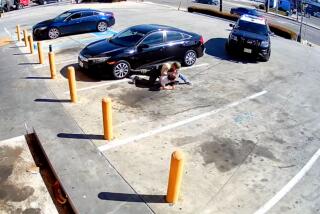Despite grand jury findings, fallout from O.C. jailhouse snitch scandal is far from over
- Share via
When a grand jury released its report last week on a scandal that has plagued Orange County law enforcement for years, it made its conclusion clear in the title.
“The Myth Of The Orange County Jailhouse Informant Program” sharply contradicted claims that sheriff’s and district attorney’s officials had run a secret operation that employed jailhouse snitches to obtain confessions from criminal defendants.
But the grand jury’s report is unlikely to be the final word as a slew of questions persist about the handling of jailhouse informants.
The U.S. Department of Justice and the California attorney general’s office are actively investigating the matter.
A Superior Court judge who has said evidence points to the existence of an informant program is now holding a lengthy hearing on how much sheriff’s officials knew about the use of snitches in the county lockups — a hearing where Sheriff Sandra Hutchens is expected to testify later this month.
And Anaheim police launched a separate investigation, sparked by criticism from the grand jury, into the department’s handling of informants in a 2011 gang investigation.
Some defense attorneys have blasted the grand jury’s findings and questioned how the panel could consider its investigation complete while court hearings about the matter remain ongoing.
“Just because some grand jury didn’t do their job, or came to this from a particular vantage point, doesn’t change the facts,” said Orange County Asst. Public Defender Scott Sanders. “These folks knew too little and didn’t want to know too much.”
The scandal grew out the murder case against Scott Dekraai, a former tugboat captain who confessed to shooting his ex-wife and seven other people at a Seal Beach salon in 2011.
Sanders, who is representing Dekraai, has claimed prosecutors and deputies conspired to house a longtime jail informant next to Dekraai in order to obtain information that could lead to a death sentence. Since the informant, a reputed Mexican Mafia shot caller, was acting as an agent of the government, Dekraai’s right to have his lawyer present was violated, Sanders argued.
Prosecutors have dismissed the placement of the informant as “purely coincidental.” During an ongoing evidentiary hearing in Dekraai’s case, sheriff’s deputies have blamed the misuse of informants on a small number of colleagues in the jails. The grand jury report came to the same conclusion, saying any misconduct was “the work of a few rogue deputies who got carried away with efforts to be crime-fighters.”
But Sanders’ allegations have frozen sentencing proceedings against Dekraai, who pleaded guilty to the murders in 2014. A year later Superior Court Judge Thomas Goethals barred Rackauckas’ office from prosecuting the case, ruling that authorities failed to turn over key information about the use of informants. Dekraai’s prosecution is now being handled by the attorney general’s office.
Goethals has said he is “satisfied beyond any doubt” that the Sheriff’s Department had a program that placed informants next to inmates with the aim of coaxing confessions out of them — a practice the law forbids. An appellate court upheld his decision to remove the district attorney’s office from Dekraai’s case in an opinion that echoed Goethals’ comment, saying the Sheriff’s Department was running a “sophisticated” informant program in the jails.
Goethals is now hearing daily testimony from county jailers on what they knew about the informants and their work in the jails and why sheriff’s officials have repeatedly failed to turn over evidence.
It’s a whitewash.
— Paul Wilson, whose wife was killed in the Seal Beach shooting, of the grand jury’s report
A relative of one of Dekraai’s victims assailed the grand jury report as nothing more than the work of puppets serving at Rackauckas’ behest.
“We’re sitting through this for the last two years listening to this snitch scandal and they’re calling it a myth?” said Paul Wilson, whose wife was killed in the Seal Beach shootings, during a break in the evidentiary hearing in Santa Ana. “It’s a whitewash. They’re supporters of Tony Rackauckas and his incompetent D.A.’s office. His office had [the Dekraai case] and blew it and turned it into a shambles, and there’s no excuse for that.”
Carrie Carmody, the grand jury foreperson, defended the findings, which also called on Goethals to end his inquiry and leave the investigating to state and federal authorities. She said her staff launched a thorough and objective investigation, free of influence from Rackauckas or Hutchens.
“Nobody on this jury came in advocating for the sheriff and the D.A. from the start. We went where the evidence followed,” she said. “I don’t think our report completely exonerates anybody. It simply says there wasn’t a conspiracy.”
A spokeswoman for the district attorney’s office referred questions to a statement issued by the agency earlier this week. In those remarks, Rackauckas praised the grand jury report and dismissed the controversy as a product of Sanders’ attempts to spare Dekraai from a death penalty verdict and excessive, inaccurate media coverage.
A Sheriff’s Department spokesman said he could not comment further due to the pending court hearing, adding only that the agency welcomes the continued investigations.
In addition to affecting Dekraai’s case, the scandal has led to retrials in at least three other murder cases across Orange County in recent years. In two of those, judges ruled that prosecutors had unlawfully withheld information about the use of informants, or their background as prolific snitches, from defense attorneys. In a third, prosecutors and defense attorneys agreed to vacate a murder conviction after it was found that some information was mistakenly withheld in discovery.
One of those defendants was convicted of a lesser charge during his retrial and the other received a lighter sentence as part of a plea deal. The third defendant, Henry Rodriguez, is awaiting retrial in connection with the 1998 killing of a pregnant woman.
Sanders and defense attorney James Crawford, who secured the retrial for Rodriguez last year, said the grand jury failed to conduct a thorough investigation. In addition to publishing their report before Hutchens could testify in the Dekraai hearings, grand jurors did not interview several defense attorneys involved in cases related to the scandal, according to Sanders and Crawford.
Sanders said he was the only one summoned to appear.
“I never even got a message, not a phone call,” Crawford said. “How are they making decisions that there’s not a system-wide program?”
Carmody did not respond to calls seeking comment about the timing of the report’s release during the evidentiary hearing in Goethals’ courtroom or criticism that defense attorneys weren’t interviewed.
In addition to the rulings of Goethals and the appellate court, some sheriff’s officials have acknowledged the existence of an informant operation in the jails.
Orange County Sheriff’s Department Lt. Martin Ramirez, a former sergeant in the jails who testified under immunity, said in court this week that a part of the jail had been used to place informants next to inmate “targets” with the aim of gathering information.
In its report, the grand jury said the use of informants in the jail was normally “organic,” with inmates volunteering information rather than being recruited by deputies. The grand jury reviewed thousands of pages of log entries by deputies tasked with handling informants in the jail. Sanders has argued that the documents are proof of a jailhouse snitch network, but the report dismissed the log’s importance, criticizing deputies only for making “juvenile, ethnically insensitive” comments within its pages.
I don’t think our report completely exonerates anybody. It simply says there wasn’t a conspiracy.
— Carrie Carmody, foreperson of the Orange County grand jury
The log is under seal. A sheriff’s department spokesman declined to comment on its contents or on what, if any, discipline has resulted against deputies over the handling of jail informants.
Two deputies are on administrative leave as a result of the scandal, and their internal affairs cases remain on hold until the state and federal probes are resolved, according to Capt. Tom Dominguez, president of the union that represents sheriff’s deputies.
The grand jury report raised concerns about the Anaheim Police Department’s use of informants, saying the agency failed to tell prosecutors about the backgrounds of two informants whose testimony was used to bring charges against roughly 30 gang members in 2011. In a statement, Anaheim Police Chief Raul Quezada said he had ordered an internal review.
Earlier this year, Crawford filed a motion seeking to vacate the conviction in a 2008 Anaheim murder case.
His client’s conviction was based largely on the testimony of one informant and a co-defendant, Crawford has said. One of them, he said in court records, was a known snitch housed in Orange County’s jails.
Crawford’s court filing alleges that prosecutors failed to disclose the informant’s history of aiding police and the co-defendant’s discussions with an investigator about a possible lighter sentence in exchange for his testimony. A judge has yet to decide the merits of the filing.
Follow @JamesQueallyLAT and @LATChrisGoffard for news about the Orange County informant scandal.
ALSO
A shopping trip leads to a scuffle between North Koreans and Homeland Security officials in New York
Lawsuit alleges hostile environment for Jews on San Francisco State campus
More to Read
Sign up for Essential California
The most important California stories and recommendations in your inbox every morning.
You may occasionally receive promotional content from the Los Angeles Times.












